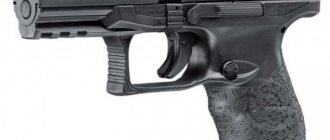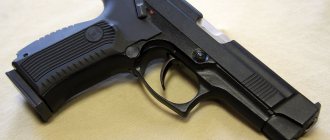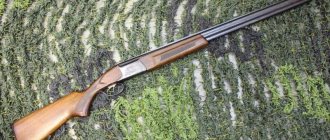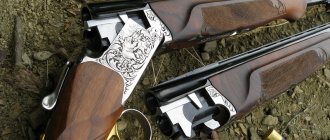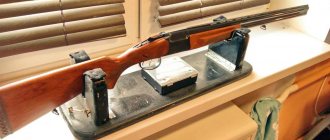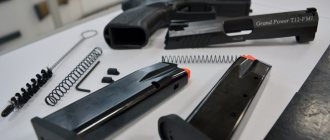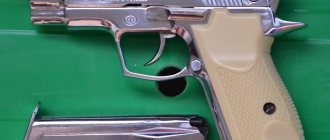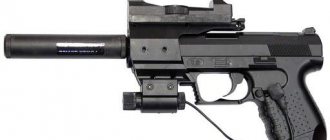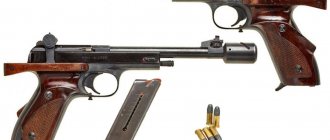History of creation
The 9 mm Walther PPK pistol was created on the basis of the Model PP pistol by Carl Walther GmbH Sportwaffen, released in 1929. Since 1908, Walther had produced several semi-automatic pistols that had a reputation for being well made and reliable, but the PP was an important step in a new direction.
As the name suggests, it was designed to be carried by police officers and was based on the differences in attitudes towards police weapons across continents. While Americans preferred relatively large-caliber revolvers, Europeans chose smaller, lighter pistols more suitable for densely populated cities.
The PP model was one of the first pistols to be made from alloy rather than steel, allowing for significant weight savings. This solution was appreciated by experts, but the police needed a smaller version that could be carried discreetly by plainclothes officers and undercover detectives.
The result was the Walter PPK (Polizei Pistole Kriminal or Police Detective Pistol).
general description
The Walther PPK pistol is a semi-automatic blowback pistol. Today, PPK pistols are manufactured by Carl Walther GmbH Sportwaffen in Germany or under license from Walther in France and the USA. These pistols have an exposed hammer, a double-action trigger, and a fixed barrel that also guides the pistol's recoil spring. The store is single-row.
Characteristics of the cooled pistol Chiappa Bond SO (SKhP, 10TK, Walter PPK)
| Type | Chilled pistol |
| Manufacturer | Chiappa |
| Combat prototype | Walther PPK (Germany) |
| Caliber | 10 TK |
| Ammunition | Light and sound cartridges 10TK |
| Number of charges | 5 pieces |
| Possibility of disassembly/assembly | Eat |
| Shooting mode | Semi-automatic |
| Shutter material | Metal |
| Frame material | Metal |
| Color | Black |
| Size | 153mm x 120mm x30mm |
| Weight | 530 grams |
| Peculiarities | Single action trigger, barrel pinned |
| Country of Origin | Italy |
| Equipment | Pistol, passport (instructions), case |
Chiappa Bond CO cooled pistol (SHP, 10TK, Walther PPK) buy in the Popadiv10 online store. Cooled pistol Chiappa Bond CO (SKhP, 10TK, Walther PPK) at a low price of 15,500 rubles. You can pay for your order by mail upon receipt in any part of the Russian Federation. Before placing an order, be sure to check the price and contents of the product by phone (during business hours) or by e-mail and feedback system (at any time convenient for you).
Information on the product “Chilled pistol Chiappa Bond SO (SKhP, 10TK, Walther PPK)” is for informational purposes only and is not a public offer determined by the provisions of Article 437 of the Civil Code of the Russian Federation; characteristics, appearance, color and equipment can be changed by the manufacturer without notifications.
Device and design features
Possessing compactness and serious stopping power, the PPK instantly became popular with European police. But why? What made the Walther PPK so successful that it continues to be produced even 90 years after its introduction?
The answer lies in its design, much of which was taken from the Walther PP. It combines a very complex mechanism with a very simple execution.
The weapon works by having the top of the weapon act as a bolt that is pulled back by the powder gases when fired. This activates a mechanism that ejects the cartridge case and loads the next cartridge from the magazine into the chamber.
The PPK has what is known as a blowback design, in which the barrel is mounted to the pistol frame and acts as a guide for the recoil spring. This not only simplifies the mechanism, but also makes the PPK more accurate than comparable tilt-barrel models. Unfortunately, it also causes the weapon to bounce more when fired because the mechanism doesn't absorb much of the recoil.
Because the PPK was designed for concealed carry in situations where a holster must be abandoned in favor of a pocket or belt, the Walther PPK is designed with a strong focus on safety. Its streamlined design prevented anything from snagging on clothing, and the mechanism had a number of features to prevent accidental firing, even with a cartridge in the chamber.
The firing of the safety is blocked by the firing pin, so it cannot reach the cartridge primer. The safety then rotates the steel lock behind the firing pin to prevent the hammer from striking it, and if the hammer is cocked, the safety “releases” it safely.
Another safety feature is the signal pin. It is a small metal pin that protrudes from the rear of the pistol's slide when the chamber is loaded.
Walter PP and PPK
The PPK is in many ways similar to its predecessor, but has a number of differences and improvements. The PPK is 0.6 inches shorter than the PP and has plastic grips on the pistol grip. The PPK also has a shorter handle and the magazine holds one less round.
Principle of operation
The main feature that really set the PPK apart when it was introduced was that it was the first successful single/double action trigger pistol to come to market. This means that the PPK combines two basic gun operating principles into one pistol.
Simply put, with single action the hammer must be cocked before each shot. Pulling the trigger only releases the hammer. In a pistol with a double-action trigger, pulling the trigger both cocks and releases the hammer when the pistol is fired. Each time the trigger is pulled, the hammer is pulled back again.
Each subsequent press releases the hammer as if it were a single action, repeating the cycle. This made PPK much faster and easier to use when needed in a hurry. In addition, by combining these two operating principles, the PPK added another safety factor: the first pull of the trigger required significant force, which reduced the likelihood of accidental operation.
Specifications
| Caliber | 7.65 Browning/9mm Short |
| Gun length | 154 mm |
| Barrel length | 83 mm |
| Height | 99 mm |
| Width | 30 mm |
| Curb weight | 568 grams |
| Magazine capacity | 7 or 6 rounds |
Advantages and disadvantages
Incredibly compact: the weapon is suitable for concealed carry.
Light weight. The weight of the unloaded pistol is only 568 grams.
High stopping power
High return. Due to the use of a powerful cartridge and a non-fixed barrel, the weapon has serious toss when fired.
Walther PPK
1931 was the year of the appearance of a new self-loading pistol, which is known as the “Walter PPK”. The basis for its design was the German PP pistol. The Walther PPK has been used by German criminal police since 1935. Unlike the previous version, this model is lighter and weighs no more than 0.590 kg. The entire length of the weapon was 15.5 cm. The barrel in this rifle unit was shortened to 8.3 cm. The width of the pistol was also reduced and amounted to 2.5 cm. However, the German designer increased the height by 9 mm. Shooting was carried out with 7.65x17 cartridges; 9x17; 6.35x15 mm and 22LR. Just like the Walther PP, the PPK uses the blowback recoil principle. A pistol with magazine ammunition. The capacity of the clips was 7 and 9 rounds. The first option is equipped with 7.65x17 mm ammunition, the second - 22LR. Model with constant sight.
Post-war use
After the war, the PPK was adopted by many intelligence agencies, including the British MI5 and MI6, the German BND, the French SDECE, the Israeli Mossad and the Swiss Intelligence and Security Service. Even Communist China's Intel service and East Germany's Stasi used PPK clones. It also served as the model for the Soviet Makarov, the Hungarian FEG PA-63, the Polish P-64, the American Accu-Tek AT-380 II and the Argentine Bersa Thunder 380.
However, the Walther company itself fell on hard times, as the Allies banned Germany from producing weapons, and the original plant ended up in the Soviet occupation zone. Using some salvaged design documents as collateral, the company settled again in Ulm and survived by licensing PPK production to the French company Manufacture de Machines du Haut-Rhin (Manurhin) until Walther resumed production in Germany in 1957.
Despite this setback, PPK remained fantastically popular with the public, especially in America. Many returning American soldiers smuggled in PPK that they had acquired in one way or another. In fact, so many of them made it to the States that a cottage industry emerged in the market for these "liberated" PPKs and lasted until the 1960s.
Many PPKs had to sneak into the US through some legal trickery because in 1968 the US government passed a law prohibiting small pistols from being imported into the country unless they met certain conditions. This ban kept PPK out of US stores until Walther came up with the PPK/S variant to get around the ban. Walther mated the PP frame to the PPK slide and barrel to make it 1.8 oz (51 g) heavier and 0.2 in (5.1 mm) taller. Walther then added the letter S to the model designation, which stands for "Sport", and overcame limitations in the company's largest market.
In 1983, Walther began manufacturing the PPK and its variant PPK/S in the United States under license first from Ranger Manufacturing and then from Smith and Wesson. The latter featured minor changes such as a longer "beavertail" to protect the shooter's hand during bolt movement and a modified chamber to prevent the weapon from jamming with the introduction of new hollow point ammunition.
